Key takeaways
- Camera gear organization enhances accessibility and efficiency, allowing photographers to focus on creativity without distractions.
- Utilizing quality bags, modular inserts, and zippered pouches protects equipment and prevents damage during travel.
- Regular maintenance, including gear checks and cleaning, is crucial for prolonging the lifespan of camera equipment.
- Implementing a labeling system for storage helps streamline the workflow and improves the overall shooting experience.
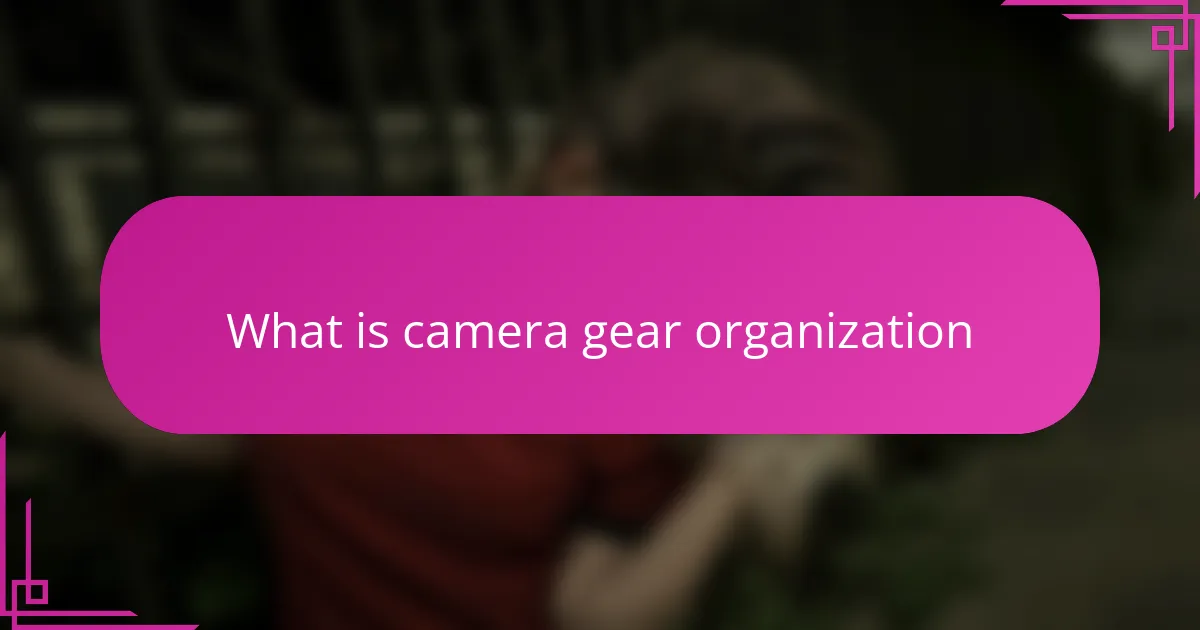
What is camera gear organization
Camera gear organization is all about creating a system that keeps your equipment neat, accessible, and protected. From my experience, it means having a dedicated place for every lens, battery, and cable so I’m never scrambling before a shoot. Isn’t it frustrating when you can’t find that one crucial piece right when inspiration strikes?
I’ve found that organizing gear isn’t just about tidiness—it’s about peace of mind. Knowing exactly where everything is allows me to focus fully on capturing the moment rather than worrying about missing tools. It’s like setting the stage for creativity, ensuring that nothing gets in the way of my workflow.
Ultimately, camera gear organization is a personal ritual that evolves with your needs and shooting style. For me, it’s as much about respecting my craft as it is about efficiency. How you arrange your gear speaks volumes about how you approach photography itself.
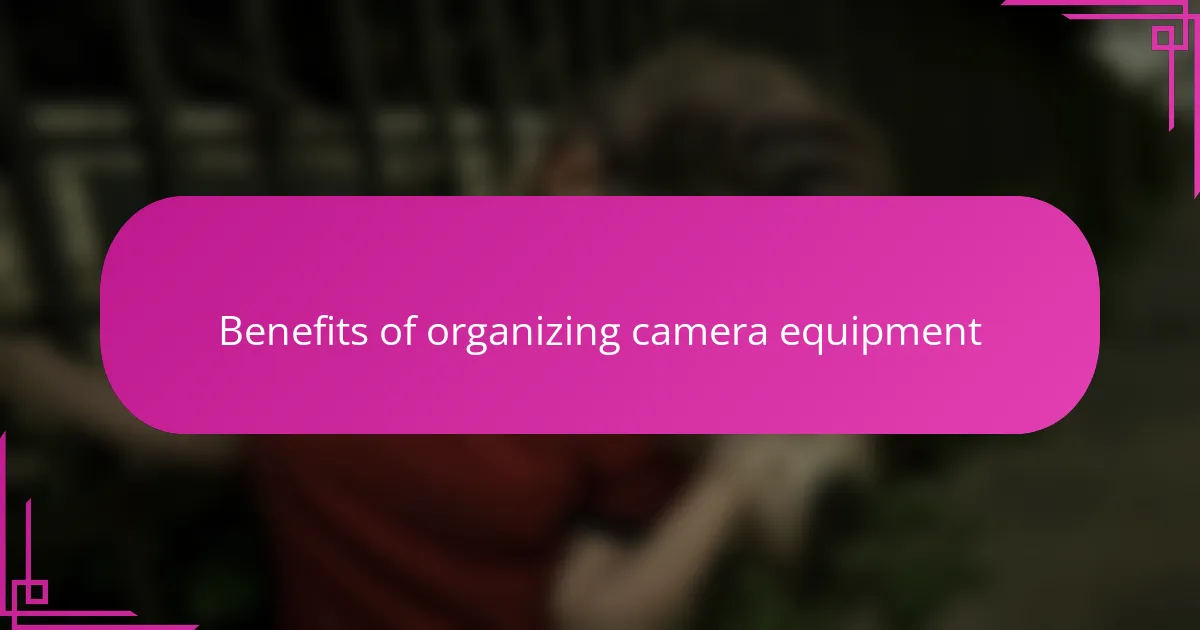
Benefits of organizing camera equipment
When my camera gear is organized, I save so much time that would otherwise be lost hunting for the right lens or battery. Have you ever felt the stress of being late to a shoot just because you couldn’t find your equipment? That frustration disappears when everything has its place.
Organizing also protects my gear from damage. I remember once accidentally dropping a lens because it was loosely thrown in my bag—since then, I’ve made sure every piece is safely stored, which gives me peace of mind and confidence when I’m out shooting.
Plus, a well-organized setup sparks creativity in unexpected ways. When I’m not distracted by searching for gear, I’m free to experiment and focus on capturing the moment. Don’t you think being in the flow is one of the best feelings a photographer can have?
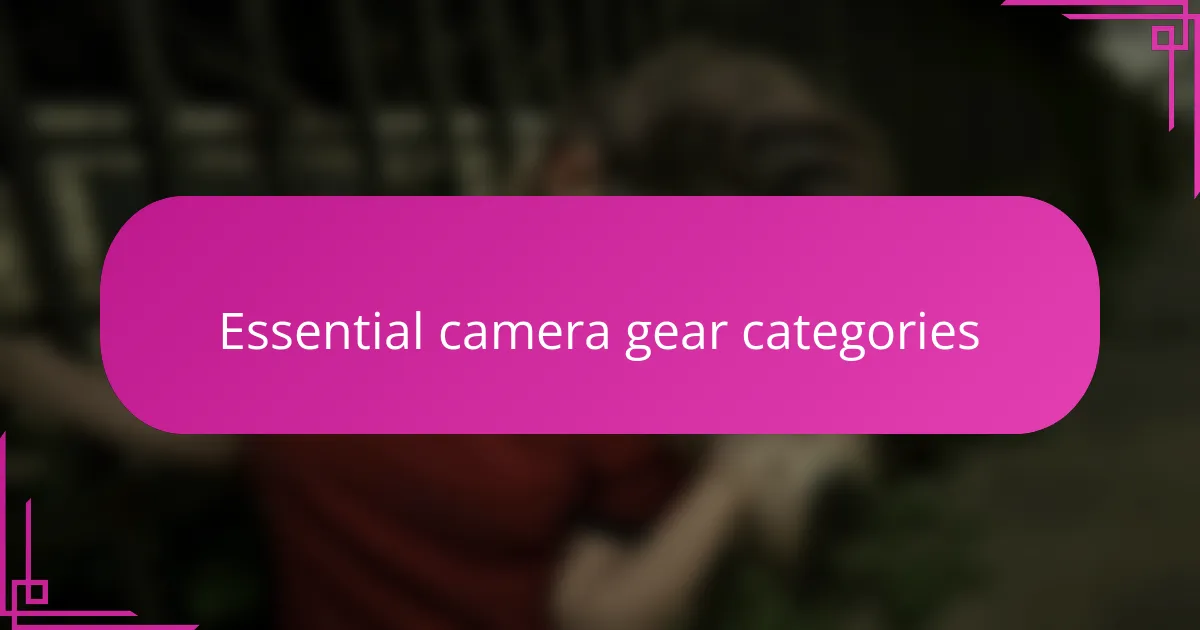
Essential camera gear categories
When I think about essential camera gear categories, I usually start with the core: my camera bodies and lenses. These are the heart of any shoot, and having them properly separated and padded is crucial. Ever tried digging through a tangled mess of lenses just before a sunrise shoot? Yeah, not fun.
Next up are the smaller but equally important items like batteries, memory cards, and chargers. I keep these grouped in a compact pouch because losing power or storage space mid-session is a nightmare I’ve faced more than once. How do you handle these tiny but vital pieces in your kit?
Finally, I pay special attention to supporting gear—tripods, filters, and cleaning tools. They might not be in the spotlight, but they can make or break a shoot. I once forgot my lens cloth during a dusty hike, and the missed shots still sting. That taught me to always keep this category within easy reach.
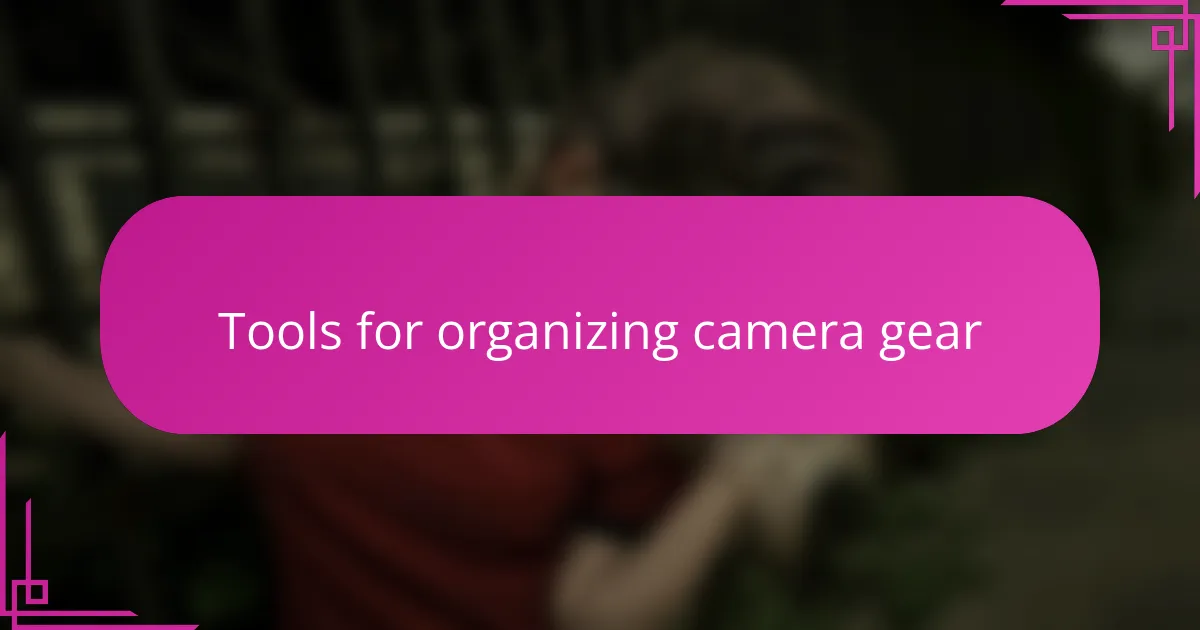
Tools for organizing camera gear
When it comes to tools for organizing camera gear, I’ve found that investing in quality padded camera bags and modular inserts makes a world of difference. These tools create designated compartments for each item, preventing everything from jostling around during travel. Have you ever pulled out your bag only to find your delicate lens scratched or worse? That’s exactly what these organizers help me avoid.
Another tool I rely on is small zippered pouches for accessories like batteries, memory cards, and cables. Keeping these essentials separated and visible means I’m never searching through a chaotic tangle mid-shoot. I remember a time when I wasted precious minutes untangling cords, only to miss a fleeting sunset moment—a frustrating lesson that changed my packing habits forever.
Lastly, a sturdy tripod bag and protective cases for filters and cleaning kits complete my system. These tools may seem minor, but they safeguard gear that often gets overlooked. Isn’t it amazing how small organizational tools can save you from big headaches down the road? For me, they’re essential companions on every photography adventure.
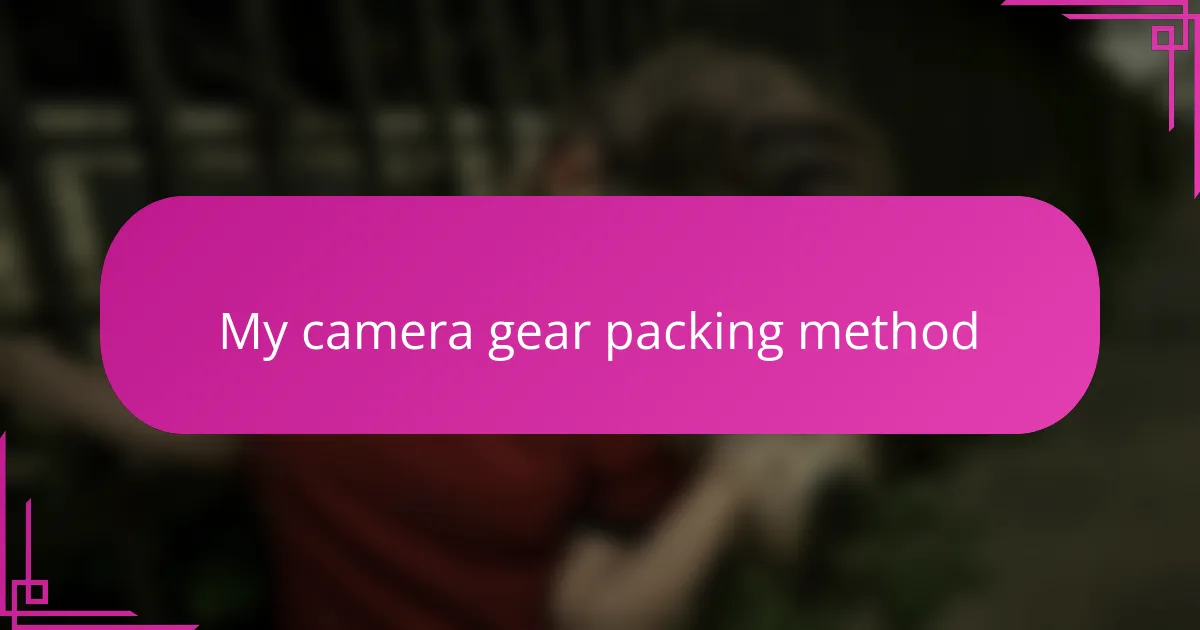
My camera gear packing method
When I pack my camera gear, I start by laying everything out on a flat surface. This simple step helps me see what I have and decide what’s truly necessary for the shoot. Have you ever thrown your equipment into a bag last minute, only to realize halfway through that you forgot something critical? That stressful moment is exactly why this ritual gives me peace of mind.
I use modular inserts that fit perfectly inside my camera bag, creating snug compartments for each piece—lenses, camera bodies, batteries, and accessories all have their own spot. This method stops anything from shifting around, which I’ve learned the hard way after a lens got scratched during a bumpy hike. Protecting my gear feels like protecting my investment and my art.
Finally, I always pack my smaller essentials—like memory cards and lens caps—in zippered pouches that I can quickly grab without rummaging. These little pouches might seem trivial, but they’ve saved me from fumbling in stressful moments more times than I can count. Don’t you find that having a reliable system elevates not just your gear’s safety, but your entire shooting experience? That’s exactly how I feel every time I zip up my bag, ready to go.
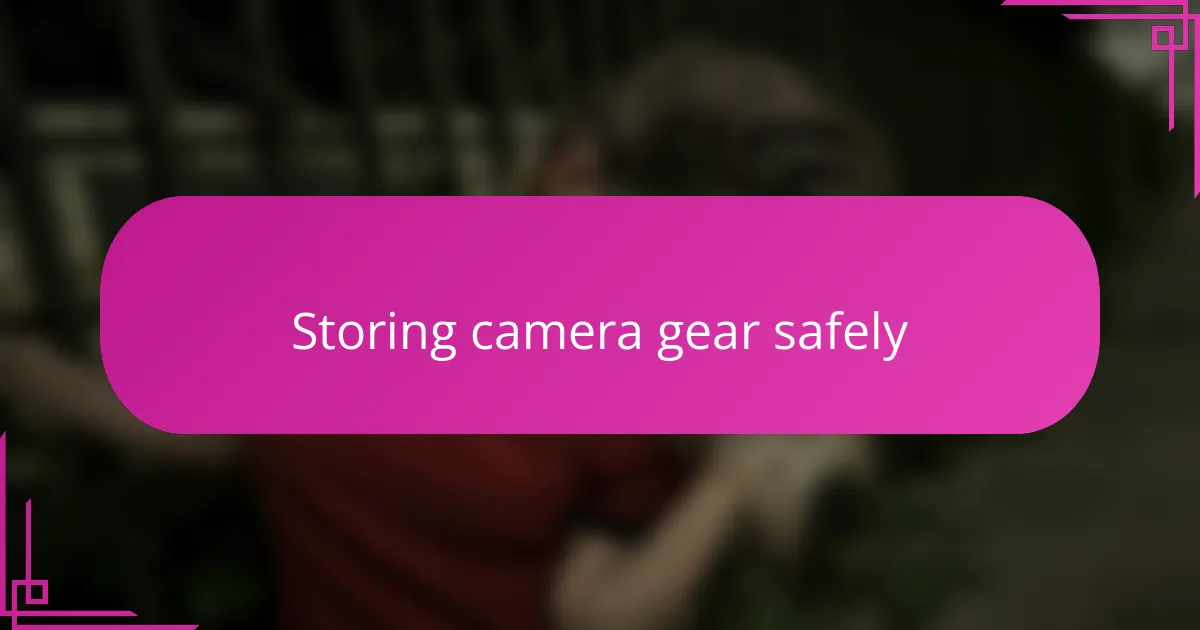
Storing camera gear safely
Storing camera gear safely is something I take very seriously because I’ve seen firsthand how a small accident can cost you big. Once, I left a lens loosely tucked in a backpack compartment, and the next day, a minor drop left a permanent scratch. Since then, I always use padded compartments and hard cases—not just for protection, but so my mind can focus on shooting without that nagging worry.
Humidity and dust are silent enemies that can damage delicate electronics over time. I keep silica gel packets in my camera bag because it’s such an easy way to absorb moisture, especially when shooting in damp or humid environments. Have you ever opened your bag after a rainy day and noticed that musty smell? That’s a warning sign, and a little prevention goes a long way.
I also make it a point to store gear in a dedicated, stable place at home, away from direct sunlight or drastic temperature changes. It might sound simple, but trust me, leaving your camera in a hot car or near a window can shorten its lifespan. After all, treating your equipment with respect is just another way of honoring the craft you love.
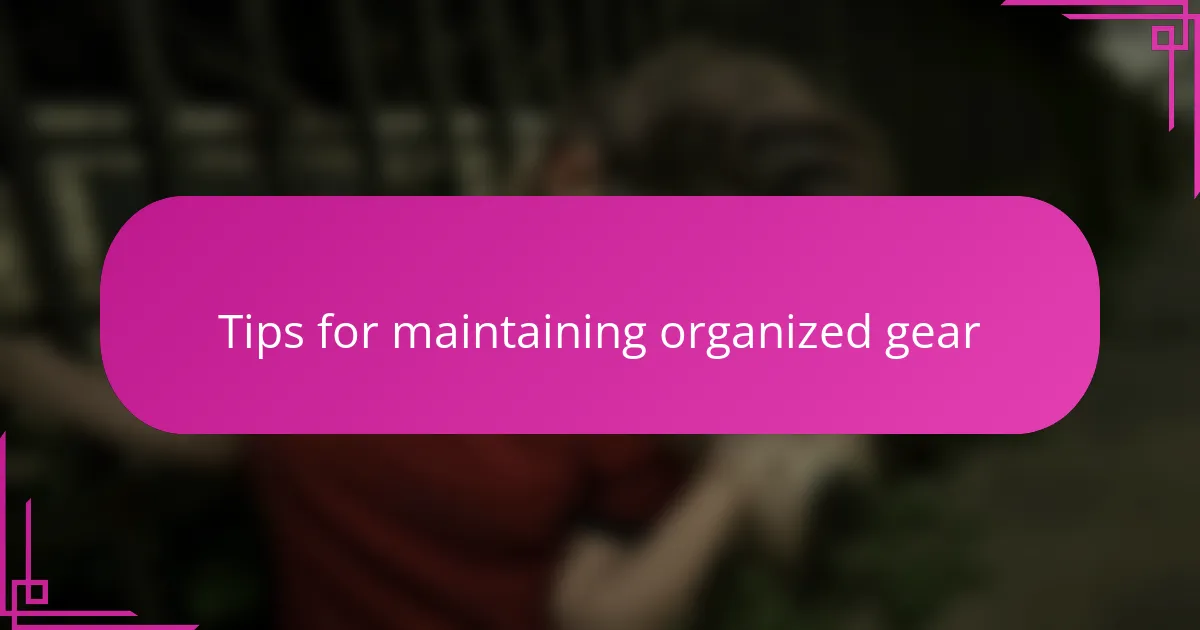
Tips for maintaining organized gear
One tip I swear by is doing a quick gear check after every shoot. It only takes a minute but saves me from the panic of realizing I left a memory card or lens cap behind. Have you ever frantically retraced your steps because you forgot to double-check? That feeling of relief when everything is accounted for afterward is priceless.
I also make it a habit to clean and repack my gear regularly, not just throw it back in the bag. This ritual helps me spot anything that needs attention before it turns into a bigger problem. For example, catching a sticky lens filter early saved me from frustrating day-long malfunctions later on.
Finally, labeling storage compartments or pouches has been a game changer for me. At first, it felt a bit tedious, but now I can grab exactly what I need without second-guessing. Isn’t it amazing how a small label can turn chaos into calm? This simple step keeps my workflow smooth and stress-free.